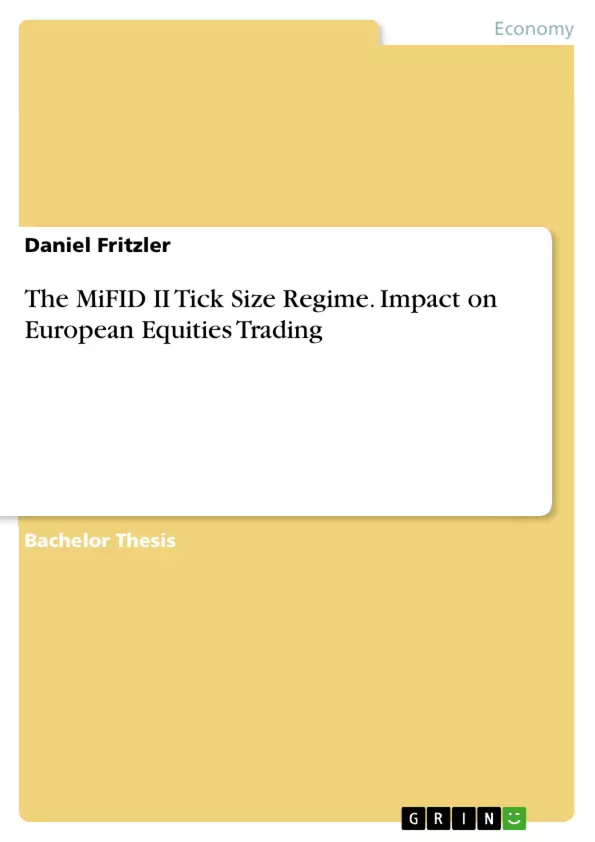Before the Markets in Financial Instruments Directive (MiFID I) was applied in 2007, exchanges were able to implement their own tick size without being concerned about competition, since trading was concentrated to the incumbent exchanges. The increased fragmentation and competition after the introduction of MiFID I in Europe started a race between the incumbent exchanges and alternative venues towards everfiner tick sizes in order to offer better prices and gain market share. Over the past few years, this trend has increased and caused adverse effects on the market quality. On March 3rd, 2018, MiFID II introduced a harmonized tick size regime that takes each stock's price and liquidity into account in order to address the negative impact of the \race to the bottom" that began with MiFID I.
The aim of this bachelor thesis is to investigate whether the introduction of the MiFID II tick size regime has achieved its desired effect of positively impacting the European equity market quality. Therefore, I will study and summarize the existing literature about the general effect of tick size changes on security markets, whereby I distinguish between tick size changes that are caused by changes in tick size rules and price movements. Furthermore, I will introduce the main concepts of the new regulatory framework Markets in Financial Instruments Directive II / Markets in Financial Instruments Regulation (MiFID II/MiFIR) with a focus on the new tick size regime and its consequences for the European market. The core of this paper is the empirical study on the effects of tick size changes brought about by MiFID II's tick size regime on market quality, using data from the German home market Xetra. I will first investigate the overall impact of the regime on the most frequently traded stocks listed on Xetra by observing different measures of liquidity, such as transaction costs, market depth, trading volumes and price volatility. In addition, I provide separate results for the different effects of decreases and increases in tick size. Secondly, I examine the impact of the new regulatory framework and its tick size regime on the market share redistribution in Europe. This allows to determine whether the contentious exemption of systematic internalisers from the regime creates an unfair advantage at the expense of regulated markets.
Inhaltsverzeichnis (Table of Contents)
- 1 Introduction
- 2 Background Information
- 2.1 Tick Sizes
- 2.2 Trading Process
- 2.3 Price-Time Priority
- 2.4 Measures of Liquidity
- 3 Literature Review
- 3.1 Impact of Tick Sizes
- 3.1.1 Changes in Tick Size Rules
- 3.1.2 Price Movements
- 3.1.3 Fundamental Impact
- 3.1 Impact of Tick Sizes
- 4 Changes Brought About By MiFID II
- 4.1 Tick Size Regime as defined in Article 49
- 4.2 Changes on the German Equity Market
- 4.3 Implication for the European Equity Market
- 5 Empirical Design
- 5.1 Sample & Data
- 5.2 Methodology
- 5.3 Analyzed Parameters
- 6 Empirical Results
- 6.1 Impact on Liquidity
- 6.1.1 Bid-Ask Spread
- 6.1.2 Order Book Depth
- 6.1.3 Turnover
- 6.1.4 Price Volatility
- 6.2 Impact on Market Shares
- 6.2.1 Market Share Distribution
- 6.2.2 Influence of the Regime
- 6.1 Impact on Liquidity
- 7 Discussion
Zielsetzung und Themenschwerpunkte (Objectives and Key Themes)
This bachelor thesis aims to analyze the impact of the MiFID II tick size regime on European equities trading. The study investigates how the new regulations have affected liquidity, price volatility, and market shares in the European equity market.
- Impact of MiFID II on liquidity measures like bid-ask spread, order book depth, and turnover.
- Influence of the tick size regime on price volatility.
- Analysis of changes in market share distribution among trading venues.
- Assessment of the influence of the MiFID II tick size regime on market shares.
- Discussion of the overall impact of the tick size regime on European equities trading.
Zusammenfassung der Kapitel (Chapter Summaries)
Chapter 1 provides an introduction to the topic of MiFID II and its tick size regime, outlining the scope and objectives of the thesis. Chapter 2 presents background information on tick sizes, trading processes, price-time priority, and measures of liquidity, laying the groundwork for the subsequent analysis. Chapter 3 reviews relevant literature on the impact of tick sizes, encompassing studies on changes in tick size rules, price movements, and fundamental impact. Chapter 4 delves into the specific changes brought about by MiFID II, examining the tick size regime as defined in Article 49, its implications for the German and European equity markets.
Chapter 5 outlines the empirical design of the study, including the sample and data used, the methodology applied, and the analyzed parameters. Chapter 6 presents the empirical results, analyzing the impact of the tick size regime on liquidity, price volatility, and market shares. Chapter 7 discusses the findings, drawing insights from the empirical results and exploring potential implications for the European equity market.
Schlüsselwörter (Keywords)
This research focuses on the MiFID II tick size regime, European equities trading, liquidity, price volatility, market shares, empirical analysis, and the impact of regulations on financial markets. The study examines the influence of the tick size regime on key liquidity measures, price dynamics, and the distribution of market shares among trading venues.
- Arbeit zitieren
- Daniel Fritzler (Autor:in), 2018, The MiFID II Tick Size Regime. Impact on European Equities Trading, München, GRIN Verlag, https://www.grin.com/document/454190



